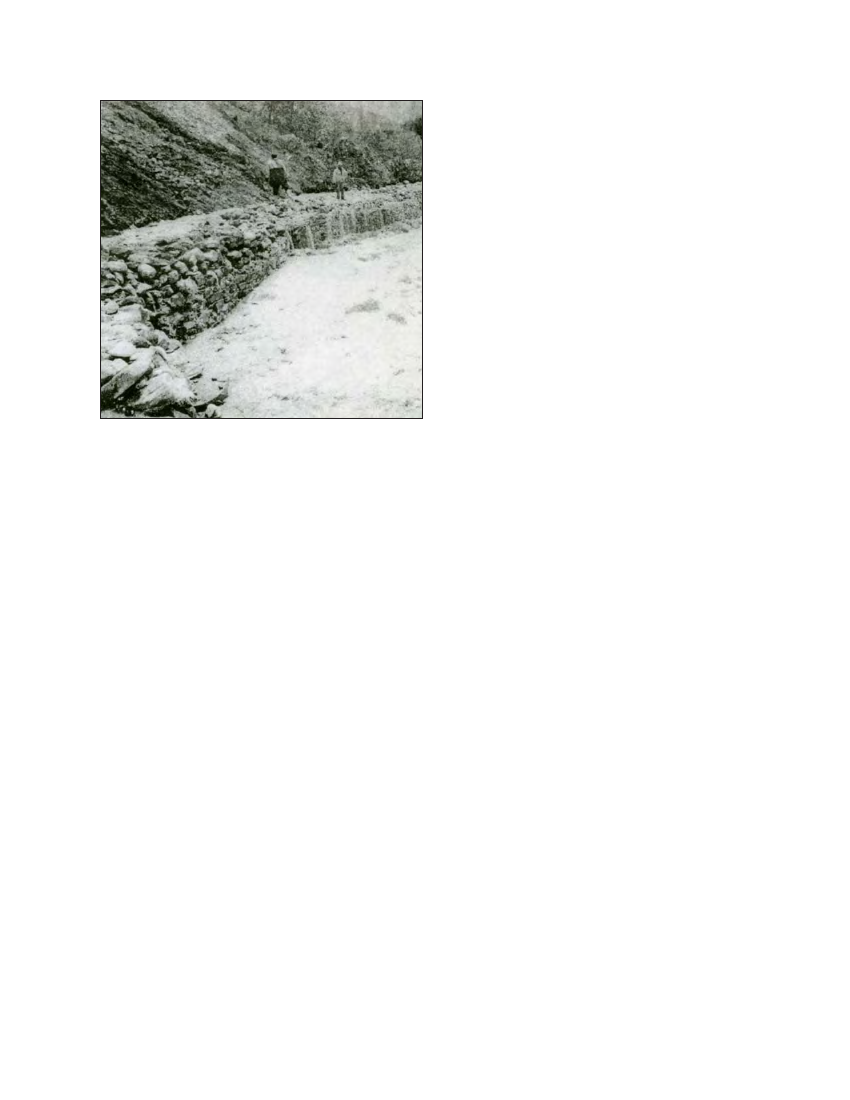
CIVIL WORKS GUIDELINES FOR MICRO-HYDROPOWER IN NEPAL
37
Photo 3.11 Gabion walls at the headworks of the 30kw Jharkot
micro-hydro scheme, Mustang, Nepal.
It is important that the culvert beneath the trash rack is steep
enough to convey the maximum conceivable sediment load
to the gravel trap: a gradient of at least 1:20 is recommended.
The gravel trap may require continuous flushing, which means
that sufficient head and surplus flow has to be available. The
design must be able to carry and spill back to the river the
maximum flow entering the intake under flood conditions.
Engineers designing a bottom intake should refer to
References 3 and 5 for further information.
3.8 River training works
A flood protection wall along the riverbank may be required if
there is a high probability of flood damage to the initial headrace
and other structures such as the gravel trap and settling basin.
Such walls are also called river training structures since they
confine the river channel. The wall height should be greater
than or at least equal to the design flood level.
The foundation of any river training walls must be protected
from undermining by the river. This can be done by one of the
following methods.
Founding the wall on rock or large boulders. For gabion
walls it may be necessary to first build up a level base using
stone masonry or mass concrete.
Founding the wall below possible scour depth.
Using a gabion mattress along the river side of the wall.
This method is not appropriate in rivers carrying a heavy
bed load, because the gabion wires will be damaged by
boulders moving during floods.
On alluvial rivers (i.e. deep deposition of sand and cobbles),
gabion flood protection walls are usually more appropriate
for micro-hydro scheme. This is because the ground of
alluvial rivers tends to change and flexible structures can
cope better in such conditions. Gabion walls may require
annual maintenance (especially after monsoon) therefore
skilled manpower should either be available at site or some
local people should be trained during the construction phase.
Gabion walls can also serve the function of retaining walls
and stabilise the slopes behind it. If slopes at the alluvial
riverbank are unstable, then gabion walls can also be
designed as retaining walls. Photograph 3.11 shows the use
of a gabion wall to stabilise the bank slope. Refer to Section
9.4 for retaining wall design. On stable riverbanks, such as
exposed bedrock, a masonry wall can be built provided that
the river does not carry large boulders that could damage
masonry structures. In large hydropower and irrigation projects
even concrete flood barrier walls are used but usually such
solutions are economically unjustifiable for micro-hydro
schemes. Figure 3.15 shows the use of a gabion wall to prevent
the river bypassing the diversion weir and damaging the
headrace pipe during floods.
3.9 Checklist for diversion works
Refer to Table 3.1 and find out what category the source
river falls in.
Refer to Table 3.2 and decide on whether a side intake or a
bottom intake is suitable.
Is a weir required or is it possible to divert the river water
without one? Remember the concept of “minimal
disturbance to the natural state of the water”.
Does the river course appear stable or does it look like it will
meander? Think about flood and flood levels. Also, if the
river carries large boulders during the floods, and a weir is
required, think about temporary diversion works rather than
a permanent weir.
To minimise flood damage the intake location should be
such that it is possible to set the headrace alignment
immediately away from the river course.
If a side intake has been selected along a river bend,
remember to locate it on the outside of the bend.
Have the flood levels and history of the river course been
discussed with the local community members?
Finally, consider the cost of different options. Is it more
economic to construct temporary diversion works and incur
some annual labour charges or to choose more permanent
diversion works?